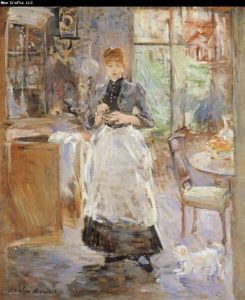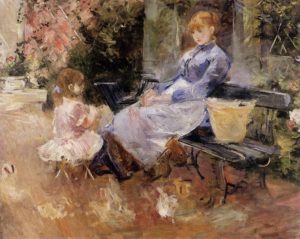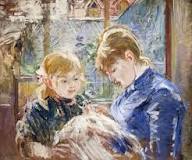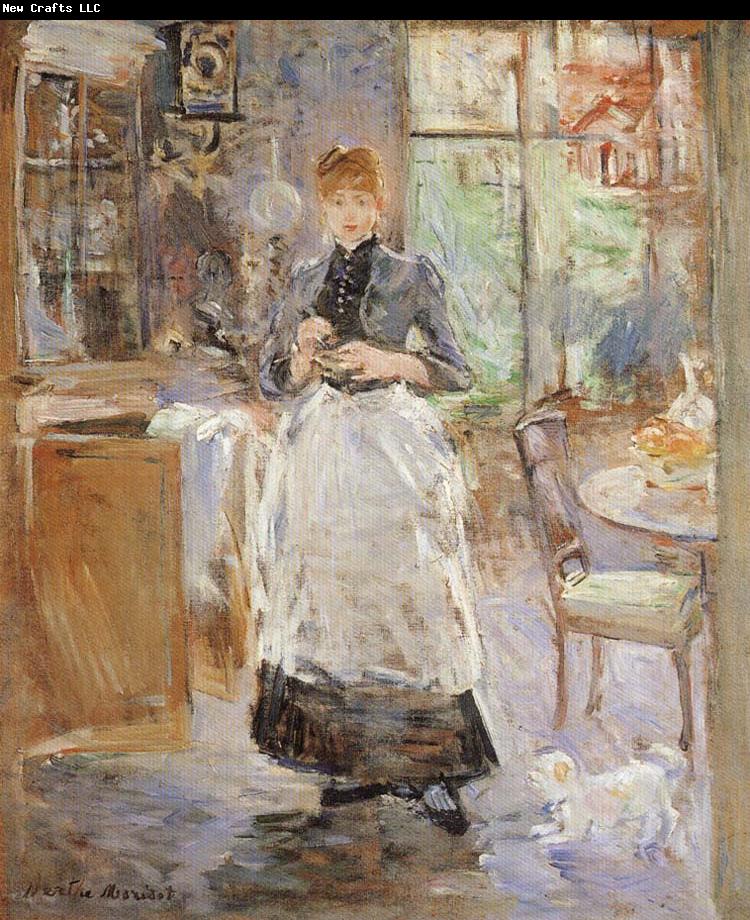In addition to using her sisters and daughter as models, Berthe Morisot also painted someone who was almost like a member of the family—her maid, Pasie.

Berthe’s mother had taken the usual route to find her lady’s maid. She brought a teenaged village girl back with her after a visit to her hometown in the south of France. Even with her auburn hair pulled into a simple bun, wearing a dark blue serge domestic’s uniform topped with a fresh white apron, Pasie was an appealing model. Berthe painted several scenes of the young maid going about her work in the dining room—clearing off the table and arranging things on the sideboard. One of these, In the Dining Room (1886) captures Pasie at the instant she turns around, inciting the family dog to yap at her twirling hem. She stirs something—furniture polish?—in a small bowl, and behind her, linens hang on the sideboard door. It is a quotidian scene but marked by Berthe’s use of light, which floods in the back window, and her broken brushstrokes that create a sense of motion in the background.
While separated by class, it’s likely that Berthe, so reserved that she was seen as aloof, was more intimate with her maid than with her social equals. Who better than the person helping you dress and arrange your hair would know which social engagements you were anticipating, and from which you returned disappointed?


When Berthe married Eugène Manet, Pasie followed the couple to their new home. Later, And when Berthe had a child, she depicted Pasie and her daughter, Julie, together in scenes like “The Fable” (1883). Julie sits listening to a story, rapt, as she is in another scene where she watches Pasie sew. It’s clear that the maid is on intimate terms with Julie, her little shadow.
When lady’s maids reached the age of thirty, they were typically let go to return to their villages, marry and start their own families. In La Luministe, I have Pasie choosing to stay after Eugène’s death, when Berthe needs her most, until Berthe makes a decision:
I let Pasie go.
One day as she was helping me with the difficult task of sorting
through Eugène’s clothes, I asked, “Is your clockmaker still waiting for you?”
She understood my meaning and burst into tears, saying. “But Madame,
how can I leave you now?”
Tears sprang to my eyes, too, and I had to pause to restrain my emotions
before I answered, “I’ve had my husband; it is your turn to be happy.”
It pleased me to think of Pasie standing behind the counter of an
horlogerie, surrounded by chiming clocks and glittering pocket watches, a much
more pleasant position than working from dawn to dusk at a bakery or grocery.
I sent her off with a trousseau of my dresses and hats that I deemed too frivolous
to wear as a widow. Pasie would return to Toulouse, where she would marry
and work next to her husband, the prettiest and best-dressed shopkeeper’s wife
in town.
Almost, but not quite, like another sister, Pasie—a poor girl from a provincial village—was immortalized by avant-garde artist Berthe Morisot.
